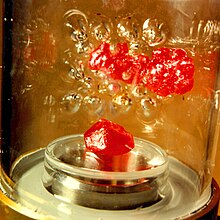Mercury(II) iodide
 Mercury(II) iodide (α form)
| |
 Mercury(II) iodide (β form)
| |
 β (left) and α (right) forms
| |
| Names | |
|---|---|
| IUPAC name
Mercury(II) iodide
| |
| Other names | |
| Identifiers | |
3D model (
JSmol ) |
|
| ChEBI | |
| ChemSpider | |
| DrugBank | |
ECHA InfoCard
|
100.028.976 |
| EC Number |
|
| 277788 | |
PubChem CID
|
|
| UNII | |
CompTox Dashboard (EPA)
|
|
| |
| |
| Properties | |
| HgI2 | |
| Molar mass | 454.40 g/mol |
| Appearance | orange-red powder |
| Odor | odorless |
| Density | 6.36 g/cm3 |
| Melting point | 259 °C (498 °F; 532 K) |
| Boiling point | 350 °C (662 °F; 623 K) |
| 6 mg/100 mL | |
Solubility product (Ksp)
|
2.9×10−29[1] |
| Solubility | slightly soluble in alcohol, ether, acetone, chloroform, ethyl acetate, CS2, olive oil, castor oil
Soluble in excess KI( Nessler's reagent
|
| −128.6·10−6 cm3/mol | |
Refractive index (nD)
|
2.455 |
| Structure | |
| Tetrahedral | |
| Pharmacology | |
| D08AK30 (WHO) | |
| Hazards | |
| GHS labelling: | |
  
| |
| Danger | |
| H300, H310, H330, H373, H410 | |
| P260, P262, P264, P270, P271, P273, P280, P284, P301+P310, P302+P350, P304+P340, P310, P314, P320, P321, P322, P330, P361, P363, P391, P403+P233, P405, P501 | |
| NFPA 704 (fire diamond) | |
| Flash point | Non-flammable |
| Related compounds | |
Other anions
|
Mercury(II) fluoride Mercury(II) chloride Mercury(II) bromide |
Other cations
|
Zinc iodide Cadmium iodide |
Related compounds
|
Mercury(I) iodide |
Except where otherwise noted, data are given for materials in their standard state (at 25 °C [77 °F], 100 kPa).
| |
Mercury(II) iodide is a chemical compound with the molecular formula HgI2. It is typically produced synthetically but can also be found in nature as the extremely rare mineral coccinite. Unlike the related mercury(II) chloride it is hardly soluble in water (<100 ppm).
Production
Mercury(II) iodide is produced by adding an aqueous solution of potassium iodide to an aqueous solution of mercury(II) chloride with stirring; the precipitate is filtered off, washed and dried at 70 °C.
- HgCl2 + 2 KI → HgI2 + 2 KCl
Properties
Mercury(II) iodide displays
metastable, eventually converting back to the red alpha form.[3] The various forms can exist in a diverse range of crystal structures and as a result mercury(II) iodide possesses a surprisingly complex phase diagram.[4]
Uses

Mercury(II) iodide is used for preparation of
Nessler's reagent, used for detection of presence of ammonia
.
Mercury(II) iodide is a
semiconductor material,[5] used in some x-ray and gamma ray detection and imaging devices operating at room temperatures.[6]
In
bursal enlargement, etc. [citation needed
]
It can appear as a precipitate in many reactions.
See also
- Mercury(I) iodide, Hg2I2
References
- ISBN 978-1138561632.
- ^ Thermochromism: Mercury(II) Iodide. Jchemed.chem.wisc.edu. Retrieved on 2011-06-02.
- S2CID 96682743.
- .
- .
- ^ Simage, Oy U.S. patent 6,509,203 Semiconductor imaging device and method for producing same, Issue date: Jan 21, 2003

